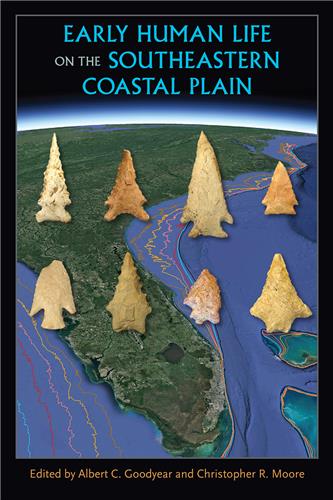Edited by Albert C. Goodyear and Christopher R. Moore. 2018. Gainesville: University Press of Florida, 434 pp. ISBN 9781683400622
Albert Goodyear and Christopher Moore’s edited volume compiles the most up-to-date paleoclimatic and archaeological research on the prehistoric Southeastern Coastal Plain of the United States. The fifteen essays review the available archaeological record to shed light on the early human occupation of the region extending from Virginia to Alabama, and the adaptive strategies to major climatic and environmental changes which occurred over the last 50,000 years. The narrative structure follows a loose chronological sequence from the earliest arrivals (Late Pleistocene/pre-Clovis) until postglacial times (early Holocene/Early Archaic). It is finely divided into four topical sections that confront the latest research trends in Southeastern archaeology: pre-Clovis contexts, demographics and settlement patterns, climate and sea level changes, and lithic artifactual analysis.
The first sub-theme covers pre-Clovis cultures in the Southeast. In Chapter 1, Goodyear and Moore introduce the natural and geomorphologic features of the Southeastern Coastal Plain and early human arrivals. The strategic location of this area, enclosed between the Atlantic on the east and the Gulf of Mexico on the west, as well as its warm weather and biotic diversity during the Late Pleistocene, turned it into an optimal scenario for human occupation. The presence of the Pre-Clovis Clarian lithic complex at Topper site (South Carolina) described by Goodyear and Stain in Chapter 2 demonstrates that humans peopled the Americas well before the Late Pleistocene. Along the same lines, Ensor (Chapter 3) describes the unique resemblance of Capps lithic technology, found at Capps-Shelley sites in Alabama, to the Old World Levallois percussion-based flat flaking technique. Hemmings et al.’s (Chapter 4) reconstruction of the depositional history at Vero site (Florida) and recovery of early Holocene nonlocal artifactual material and thermally altered animal bone, suggest human presence in the area during the Late Pleistocene.
The following thematical section focuses on settlement patterns. In Chapter 5, Harris examines the evolution of the paleolandscape along the continental shelf, from Virginia to the Gulf of Mexico. The author’s goal is to identify the regions submerged after the Last Glacial Maximum in order to locate ancient habitation sites. The results indicate that pre-Clovis and Clovis populations may have lived at the edge of the continental shelf from 75,000 to 11,000 years ago. Austin et al., in Chapter 6, apply a variant of the quarry cluster approach to assign lithic artifacts to geographic areas according to their geological characteristics, as well as visual analysis and nondestructive means. Chert procurement patterns in Florida show that Paleoindians and Early Archaic populations depended on local sources and had a relatively restricted foraging range, although they also accessed exotic stones via exchange. In Chapter 7, Smallwood et al. explore the changes in Paleoindian settlement in the South Carolina Coastal Plain based on the distribution of Clovis, Redstone, Post-Clovis unfluted, and Dalton Paleoindian points across the region, as well as the choice in raw material types, and the transport distances from source.
Chapter 8 and 9 concentrate on the Younger Dryas cosmic event which occurred 12,800 years ago. Lecompte et al. (Chapter 8) provide a thorough overview of the origin and characteristics of the cosmic impact. The authors detail the various primary and secondary impact-related proxies in the Younger Dryas Boundary layer and claim that these components can be used as chronostratigraphic datum regionally, nationally, and internationally. In the following Chapter, Kennett at al. describe the geological, environmental, and cultural consequences of the Younger Dryas cosmic collision, including abrupt cooling of temperatures, global changes in ocean circulation, Paleoindian Clovis decline, and megafaunal extinction.
In Chapter 10, Moore et al. advocate for the implementation of optically stimulated luminescence, combined with sedimentology, archaeostratigraphy, and carbon dating, to study site burial processes in shallow and sandy geologic contexts along the Southern Atlantic Coastal Plain. Their purpose is to interpret the depositional environment and timing of burial processes and link them to cultural or climatic events.
The final set of essays concentrate on stone artifact analysis. In Chapter 11, Bridgman Sweeney applies social network analysis to a large database of archaic lithic artifacts from the Early Side-Notched Horizon (11,200-10,500 calBP) to reveal ancient social boundaries and intergroup interactions within the Coastal Plain. In Chapter 12, Thulman analyzes the shape and distribution of 329 Early Archaic Bolen points to establish a rigorous typology based on morphometric analyses, and to reconstruct prehistoric social organization patterns. In Chapter 13, Wilkinson studies over a thousand Early Archaic bifaces and unifaces from the interriverine area spread between the Savannah and the Santee rivers (in South Carolina) to understand settlement organization of Early Archaic cultures and their subsistence strategies. In Chapter 14, Anderson conducts artifact morphological and distributional analyses through the lenses of network analysis and cultural transmission theory to study diagnostic stone artifacts. The goal is to delimit subregional cultural traditions likely reflecting band ranges and multiband interaction patterns.
Finally, Schuldenrein’s Chapter 15 performs as corollary and sums up the major lines of research presented in this volume. The author emphasizes the importance of reevaluating the question of the initial peopling of the Southeastern Atlantic Slope and its environmental correlates by focusing on complex human/landscape relationships and promoting the “inter-disciplinary imperative” in archaeology.
In my opinion, Goodyear and Moore have put together an accessible, yet methodologically complex, account of the early days of Paleoindian cultures in the Southeastern U.S. To non-specialists, this book provides solid background knowledge on the archaeological development of the Coastal Southeast. Although it is not meant to be an extensive and exhaustive linear chronicle of the prehistoric past of the United States, the well planned structure and the narratory flow help the reader to build an Early Amerindian timeline. Also, it inspires further reading on the field to fill up the existing (albeit inevitable) historical blanks. To specialists, the book gives testimonial evidence of the benefits of joining traditional and modern methodologies and theoretical approaches. Methodologically, these contributions are significant to the development of prehistoric archaeology in the United States as they introduce new scientific technologies into the archaeological toolkit, such as geographic information systems, digital modeling and imagery, remote sensing technology, and optically stimulated luminescence, which are interwoven with traditional methods like sedimentology, archaeoestratigraphy, carbon dating, visual analysis, and formal typology. Theoretically, this book makes a scholarly statement by addressing many of today’s controversial questions in the archaeology of the early Southeast, such as the sudden demise of the Clovis technoculture, the recognition of the mysterious “Middle Paleoindian” period, or the adoption of the Younger Dryas Hypothesis.
In sum, Goodyear and Moore succeed at consolidating the state-of-the-art knowledge of the Pleistocene and Early Holocene archaeological deposits, and presenting it as a point of departure for future inquiry.
Irene Martí Gil is a Ph.D. candidate in the department of Geography and Anthropology at Louisiana State University and the assistant curator at LSU Natural Science Museum, where she curates ethnological and archaeological collections since 2020. Her research interests range from cultural heritage studies, museology, anthropological linguistics, and archaeology.
© 2022 Irene Martí Gil
Irene Martí Gil is a Ph.D. candidate in the department of Geography and Anthropology at Louisiana State University and the assistant curator at LSU Natural Science Museum, where she curates ethnological and archaeological collections since 2020. Her research interests range from cultural heritage studies, museology, anthropological linguistics, and archaeology.


